When it feels like it’s going to take you hours to clean your home’s exterior, using a power washer can seem like an incredible idea.
With 50 times the power of a normal hose and the ability to save up to 80% of the used water, the odds stack up in the favor of power washers.
You can use these amazing tools to remove mud from your tire wells, clean the mold off the patio and its furniture, or refresh the look of your once sparkling deck.
However, using power washers can be more complicated than you’d first imagined.

To do an efficient and proper job, here are some expert-revealed secrets on how to use power washing to get the results you desire.
Although they use less water than other methods, power washers still need an adequate supply of water to operate efficiently.
A weak water supply will affect the cleaning results. That’s why the first step begins long before you turn on the power washer; you’ll need to test the water flow using a normal hose first.
The test can simply be done by filling in a 5-gallon bucket; if it’s more than two minutes to be filled, that means that the water flow is insufficient for optimum operation.
Once you can guarantee the water pressure, you’ll need to clean the inlet filter, secure the connections in place, and attach any necessary tools.
Using a power washer can look easy. After all, how hard can it be to spray water and watch as the dirt fades away?
As it turns out, it can be pretty complicated, especially if it’s your first time operating a power washer.
The force of pressure can take you by surprise if you apply too much pressure while failing to strengthen your grip. Instead, you’d do better by easing into the cleaning process.
As a rule of thumb, it’s best to keep a 10-foot distance between yourself and the object you’re cleaning.
It’s also best to operate the power washer at the lower pressure and increase it gradually and close the distance step by step until you reach optimum distance and pressure.
One of the most remarkable things about power washers is that you can change the nozzle according to your needs.
There are a variety of nozzles for different jobs, each having its own color, shape, and function.
You can use a nozzle that produces a wide-spray pattern or opt for one with narrow streams. What you should keep in mind is that the narrower the nozzle, the more pressure it will exert.
That’s why wider nozzles of 40 degrees are better suited for generic cleaning projects, ones that cover a large surface area.
Meanwhile, narrower nozzles of 25 degrees are better suited for cleaning grime stuck on concrete.
The narrowest nozzles of 15 or zero degrees work best for the most stubborn dirt, such as removing iron stains.
Power washing projects are best carried out in the spring and fall. That’s because the weather works well in favor of drying up your objects after cleaning them.
On the other hand, deciding to use a power washer during the winter is not always the smartest idea.
Especially in regions of freezing winters, the water leaked into the crevices and cracks may quickly freeze and expand, damaging your objects and blocking the narrow passages.
In case you’ll be storing your pressure washer throughout the winter season, you’ll need to winterize it. As the experts at directpowerdeals.com explain, the water remnants can freeze inside a pump and completely damage the machine during cold winters.
The nozzles can crack, the fuel can corrode the container and break the line, and the engine can be damaged from rust.
Winterizing your power washer for storage can prevent the onset of a very unpleasant surprise the next time you decide to use the machine.
Sometimes, using power washers only needs some common sense. For instance, it’s obvious that keeping the nozzle at a perpendicular angle will give you the maximum cleaning power to get rid of stubborn stains.
It’s all fun and games until you need to reach a surface that you can’t really see, like the underside of your patio or the top of your house.
In such times, switching the nozzle to one with a better angle is necessary.
Switching to an adjustable nozzle will help you clean the stubborn area without having to bend the hose or go out and beyond in your efforts to reach distant areas.
Over time, you’ll start getting the hang of the job. However, that doesn’t mean you should always wing it. Adopting some techniques can help you get the best job done without having to struggle too much.
For instance, soaking the surface first and leaving it for a few minutes can work miracles in removing caked-on gunk.
Another useful technique for using detergents is to alternate with the direction of the water. It’s better to start from the bottom up when using a detergent, maneuvering in a horizontal way so you can prevent runoff streaks.
After leaving it to soak for a few minutes, you’ll rinse the detergent by moving in the opposite direction; from top to bottom.
Although it’s practical for almost all kinds of cleaning projects, power washing still has its limitations. Some surfaces shouldn’t be cleaned using power washing, like laminar sandstone,
Masonry surfaces, painted material, asphalt roofing, old objects, and stained wood. Power washing these substances will only damage them.
Before deciding to buy or rent a power washer, it’s important to know how to use it properly.
Jumping right into the action without being well-prepared may injure you, damage your property, damage surrounding objects, or fail to deliver the results you’re seeking.
On the other hand, taking your time and easing into the job will help you both increase the efficiency of your cleaning and enjoy your time.